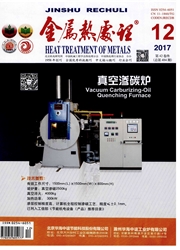

 中文摘要:
中文摘要:
研究了AZ31镁合金轧制薄板经200~400℃退火5~240 min后的组织性能演变。通过金相组织、显微硬度、室温力学性能及拉伸断口等测试技术,分析了其组织性能的变化。结果表明,AZ31镁合金轧制板材在250℃以上退火过程中的显著组织变化在几分钟内就已经发生,250℃退火10 min组织出现明显的静态再结晶组织;400℃退火在5 min内已经基本完成再结晶;发生再结晶的退火温度存在临界值,在200℃以下退火,即使经过240min也不能完成再结晶。低于350℃退火,完成再结晶后,在一定的时间内晶粒长大较慢,退火240 min后晶粒尺寸为7~8μm。轧制态AZ31镁合金板材的室温拉伸断口为准解理断裂,退火处理使板材的延性大大改善,断口呈韧性断裂。300℃×120 min退火后AZ31镁合金薄板的综合性能较好,抗拉强度为297.1 MPa,断裂伸长率为23.98%。
 英文摘要:
英文摘要:
The microstructure and mechanical properties of AZ31 magnesium alloy sheet during 200 -400℃ annealing for 5 - 240 min were investigated by optical microscopy, microhardness and mechanical properties analysis. The results show that the major microstructure transform take place in the first several minutes during annealing upon 250 ℃. Visible static recrystallization is observed after annealing at 250 ℃ × 10 min and five minutes of annealing at 400℃ are enough to fully recrystallize the microstructure. The critical temperature of recrystallization for the present AZ31 alloy sheets is determined to be 250 ℃. Temperature below 200 ℃ is not enough for static recrystallization even after 240 min. The coarsening of grains after static recrystallization is slow when annealing below 350 ℃. The grain sizes are 7 - 8 μm after annealing in the range of 250 - 350 ℃ for 240 min. The tensile fracture morphologies of as-rolled sheets are characterized as quasicleavage fracture while ductile fracture after annealing which contribute to the great improvement of ductility. An optimized mechanical property with tensile strength of 297.1 MPa and elongation of 23.98% is achieved after annealing at 300 ℃ for 120 min.
 同期刊论文项目
同期刊论文项目
 同项目期刊论文
同项目期刊论文
 期刊信息
期刊信息
